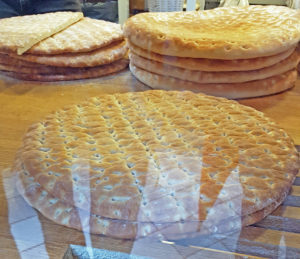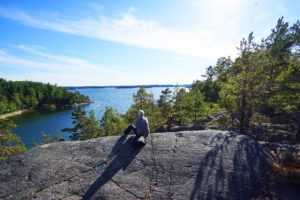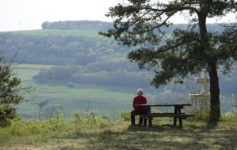
We just spent three days in Stockholm on Sweden’s southeast coast, and two days in Göteborg (Gothenburg) on the southwest coast, the first time for either one of us in Scandinavia. Paula grew up with relatives who emigrated from Sweden, so the trip was very personal for her. Here are some impressions after five days in the country of Paula’s people.
No place sounds more friendly to Americans
Whenever we travel to a new place, we vow to fight our Ugly American gene by learning a few words in the native tongue: Hello. Goodbye. Please. Thank you. Where are the toilets? English? If you throw in pointing at a menu and occasionally typing a phrase into Google Translate on your phone, these are usually enough to get you through the day just about anywhere in the world.
For Americans, Swedish is easier than most. “Hello” is “Hej,” pronounced “Hey!” Yes is “Ja.” Thank you is “Tack.” It makes Sweden one of the friendliest sounding places on earth, as all day, everyone everywhere seems to be saying, “Hey!” to each other. You almost expect them to high-five as they do it. It’s like everyone’s arriving at a party all the time.
The trouble comes when you enter a store and you say “Hej!” with just the right accent and intonation – which is easy after you’ve heard it a couple of dozen times – and then the storekeeper assumes you’re Swedish, and begins talking to you in her native tongue. It happened to us frequently, compounded no doubt by the fact that I’m a pale blue Irish person, traveling with a pale woman with very Scandinavian natural blonde hair and blue eyes, and whose people came from here.
We may never look French in France, but we have little trouble here looking Swedish. It’s one thing to know the cliché. It’s another to actually see a population in which such a huge percentage of people have natural blond hair and blue eyes. For me, it was like a visit to the unicorn stables.
The good news is that seemingly everyone in Sweden, regardless of hair color, speaks English. Younger people in particular speak English so well that you’ll swear that some of them grew up in the U.S. Usually not. Also interesting is that older Swedes tend to speak English with a British accent, while younger Swedes tend to talk with a distinctly American accent.

At the outstanding Vi Viet restaurant in Göteborg on a rainy Sunday night, our waiter, Henry, explained why. It turns out that all Swedish children learn English from very early on in school, and the English taught is essentially British English. But younger people have been immersed in American culture, most notably television programs, movies, and music, most of their lives. And, as Henry put it, British English is a bit boring. Thus, the difference in accent between young and old.
Henry is the youngest of four children born to Vietnamese parents who fled the war, and he’s the only one born in Sweden. His mother runs the restaurant, and he and his family members work the floor. It has a high rating, because it’s outstanding Vietnamese food – easily the best we’ve had since we left the U.S. Henry knew all about New Orleans, its extensive Vietnamese population, and its reputation for great Vietnamese food. He hopes to go there someday.
The most valuable tip from Henry came via his mother, who sent out a message from the kitchen after Henry repeated to her our lament that we have not yet found good Vietnamese food in Paris since coming to France. It turns out that the Vietnamese community, and all of the good restaurants attendant to it, settled in Paris’ 13th arrondissement, just south of le Jardin des Plantes on Rive Gauche. We’ve ventured to the edge of the 13th, but not yet into its heart. That’s about to change.
Our upbringing leaves us with latent and powerful connections to place
On the three-hour train ride from Stockholm to Göteborg, two women in the seats in front of us became engaged in conversation, and Paula listened intently, then started to smile. When I asked her why, she told me that while she didn’t understand the words, the conversation itself – the accents and the intonations – transported her straight back to the days when her mother, her grandmother and her aunts were together in Michigan each summer. The older women would sometimes talk to each other in Swedish, and hearing the language again was like a beloved song whose words Paula didn’t know, but whose tune was like hearing from an old friend. It was a potent reminder of how cultural heritage travels with us, and gets transferred to us, even if we’re not fully aware of it.

One thing Paula remembered vividly from her childhood is that when her grandmother would visit New Orleans from Michigan, she would make what the family knew as “Swede bread,” a kind of soft flatbread with a very distinctive pattern of holes spaced across the surface, put there by a spiked rolling pin, baked in a round pan and sliced for serving on the diagonal.
In Stockholm, she spent some time in bakeries looking for it, but never quite saw what she remembered. Then on the same train trip to Göteborg, the train staff served a meal to a very elderly and frail woman riding on the train near us. The meal included a piece of the distinctive bread that Paula remembered so well. The next day, in the food market in Göteborg, the bread vendor was selling huge slabs of Swede bread. Paula thought hard about it, and ultimately decided not to try it, for fear that it would tarnish her memory, as perfect as an old photograph, of her grandmother’s amazing Swede bread.
You can’t know Stockholm by visiting in only one season
When we visited Stockholm, a beautiful city built on an archipelago that makes water a huge part of daily life, it was sunny and warm for all three days. Everyone was happy. Everyone was outside. Almost everyone seemed engaged in some kind of healthy activity – walking, running, bicycling, playing games in the park.
We were in Stockholm with our dear friends Bill and Sean, who came up from Australia and were on their way to Estonia. Bill and Sean hosted our wedding at their home in 2015 in Fremantle on Australia’s west coast, so it was special to see them again.
One night after dinner at a bar in Gamla Stan, the old medieval center of Stockholm, we were talking about this happy, active aspect of Stockholm life. The server who brought us our after-dinner digestifs –Armagnac, Cognac, Champagne and Irish whiskey – commented that the outward happiness of Swedes was pretty much in direct proportion to the amount of sunshine they were absorbing. Things were a bit different in winter, he assured us.
We had this conversation close to 11 p.m. The sun had just set, and the sky was still a brilliant blue. Just short of the solstice, the sun stayed down only between 10:30 p.m. and 3:30 a.m. It can mess with your sleep patterns and your normal rhythms.
 Imagining Stockholm in December, one could easily surmise a different kind of place, in which the sun is only up from about 9:30 in the morning until about 2:30 in the afternoon. The rest of the time it’s dark, and cold, and windy, and sometimes wet. It’s hard to imagine quite as much joy as we saw in Stockholm on three sunny, warm days. But we’ll say this much about the Swedes: They embrace the summer with unusual gusto; they act like people who know that the clock is ticking.
Imagining Stockholm in December, one could easily surmise a different kind of place, in which the sun is only up from about 9:30 in the morning until about 2:30 in the afternoon. The rest of the time it’s dark, and cold, and windy, and sometimes wet. It’s hard to imagine quite as much joy as we saw in Stockholm on three sunny, warm days. But we’ll say this much about the Swedes: They embrace the summer with unusual gusto; they act like people who know that the clock is ticking.
Göteborg is the hippest city you’ve never heard of
Göteborg is an up-and-coming city of about a million people on Sweden’s west coast. It’s a longstanding port city, and for a while it had the rough-around-the-edges scruffiness of most port cities in the world. But in recent years, it has experienced a renaissance, and now sports lots of kitschy boutiques, endless coffee houses, an outstanding foodie scene and a hipster-cool vibe. While we were shopping for clothing at a store that proudly advertised its free trade, organic, vegan (I don’t know how clothing is vegan) free-range (I might have made that one up) cred, it suddenly occurred to me where we were: Portland.
Think of Göteborg as the Portland of Sweden. And if you get a chance to visit this friendly, interesting country, with its endless summer sunshine and inexhaustible supply of beautiful blond, blue-eyed people, you should come.
But at least for your first time, I wouldn’t come in the winter.




I cried when I saw the picture of the Swede bread.
I took it just for you!
Sounds like an amazing place. I’m enjoying reading about your adventures.
Thanks Colleen. Hope you are well.
I am loving this!
Thank you Celeste. Your new place looks beautiful. We love the light.
Your photos are beautiful. Thank you for sharing your adventures! ❤️
Thank you for following them!
So enjoying your travels. Feel I am there too!
My mother always told me to atvantage of every opportunity that comes my way, but you two took a giant step beyond that: You created your own opportunities!